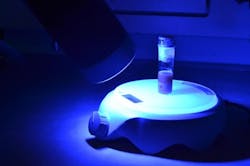Light Replaces Ligands for Synthesis
The combination of nickel and photoredox catalysis provides a cost-effective, broadly applicable method for synthesizing anilines, say researchers at Princeton University, Princeton, N.J., the Massachusetts Institute of Technology, Cambridge, Mass., and Merck & Co., Kenilworth, N.J. The route complements the conventional approach of using tailored ligands and palladium catalysts for forming the C-N bonds often needed for pharmaceuticals and fine chemicals, they note.
Figure 1. New aniline synthesis method relies on photoredox catalysis to form C-N bonds. Source: Princeton University.
“What we bring to the table… is a completely new mechanism to perform this reaction,” comments David MacMillan, a professor of chemistry at Princeton. “The approach is economically attractive as it does not require the employment of a specially designed or tailored ligand. This further simplifies how we perform the chemistry,” he explains. “Our collaboration with Merck Research Laboratories studying this method in a high-throughput fashion has indicated that a diverse sampling of complex drug-like substrates featuring a variety of functional groups can be successfully employed in this cross-coupling method.”
[callToAction]
The reaction only requires a tiny amount of photoredox catalyst, coupled with an inexpensive and simple nickel catalyst, to provide good yields for a range of coupling partners, note the researchers. The photoredox catalysts are stable and catalyst poisoning isn’t a problem with this approach, says MacMillan. Moreover, the method suits continuous synthesis.
The approach was tested on 18 complex drug-like aryl halides in the “informer library” developed by Merck. “Remarkably, 78% of substrates underwent successful cross-coupling and provided ‘reaction hits’ that were suitable for optimization,” the researchers state in a recent article about the method in Science.
Certain substrate classes, including sterically encumbered amines and amides, remain challenging, though, admits MacMillan.
“Overall, in our experience, the yields obtained with photoredox catalysts have been comparable with those obtained using more traditional methods,” he notes. “The proof of the pudding will be with complex drug-like molecules. Some of these were successfully demonstrated via the Merck informer plate platform, but it will require extensive field testing to know how successful this platform is generally.”
Performing the synthesis in a flow reactor should boost yields, says MacMillan. Fine-tuning solvent, light source, photoredox catalyst, base and temperature should enable increased yields of challenging substrates, he adds.
Laboratory trials of continuous synthesis now are underway at Princeton and should take a few months to half a year, notes MacMillan. “We have the flow process down to 15-min residence time and in the lab we can produce easily about a kg per day on a small flow reactor.”

